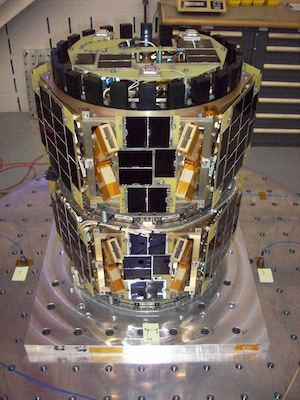CUSat-1 and CUSat-2
 Mission
Mission
The satellite has a 2 watt packet radio transmitter and carries Pulse Plasma Thrusters (PPT) which can raise or lower the orbit. Built by students at Cornell University CUSat-1/2 is a 45 kg space vehicle consisting of two functionally identical satellites that will launch together and separate in orbit. Image and positioning data will be downlinked using AX25 packet radio on 437 MHz. Cross linking between the two parts will also take place on 437 MHz.
Using centimeter accuracy carrier-phase differential GPS, the two satellites will perform autonomous relative navigation. One satellite will capture imagery of the other satellite and send these images to a ground station on Earth for the reconstruction of a 3-D model of the partner satellite.
Orbital parameters
Name CUSat NORAD 39266 COSPAR designation 2013-55-B Inclination (degree) 80.989 RAAN 301.534 Eccentricity 0.0794828 ARGP 120.062 Orbit per day 13.97114268 Period 1h 43m 04s (103.7 min) Semi-major axis 7 282 km Perigee x apogee 325 x 1 483 km Drag factor 0.000362530 1/ER Mean Anomaly 248.167
Downlink
CUSat-1 437.405 MHz FM 1k2 AFSK
CUSat-2 437.485 MHz FM 1k2 AFSK
Cross link 437.305 MHz FM 1k2 AFSK
Transmit Interval: every 1 minute, RF Power Output: 2.2 W, Antenna Polarization: circular.
Callsign
BOTTEM
TLE
CUSAT-1 1 39266U 13055B 13286.46646556 .00010669 00000-0 36253-3 0 256 2 39266 80.9891 301.5344 0794828 120.0625 248.1674 13.97114268 1923
CUSAT-2 isn’t deployed.
CUSAT-2 unknown
Telemetry
[319 Bytes KISS Frame (without CRC)] ctrl: 3 PID: F0 {UI} 300 Payload Bytes
from BOTTOM to GROUND:
1 > 00 00 00 00 01 01 00 20 01 00 00 80 D8 77 2C 62 10 E9 40 00
21 > 00 00 00 00 00 00 2E 2C 31 2E 0D 7D 04 10 00 00 00 00 00 00
41 > 00 FA 00 7E 00 00 00 00 00 00 00 00 00 90 7E 7E 7E 7E 7E 7E
61 > 7E 7E 22 00 00 00 08 11 0B 00 27 27 00 00 00 00 00 00 00 00
81 > 00 00 00 00 00 00 00 00 00 00 00 00 00 00 00 00 00 00 00 00
101 > 00 00 00 00 00 00 00 00 00 00 00 00 00 00 00 00 00 00 00 00
121 > 00 00 00 00 00 00 00 00 00 00 00 00 00 00 00 00 00 00 00 00
141 > 00 00 00 00 00 00 01 01 01 00 00 00 00 00 00 08 00 00 00 70
161 > 0E 00 00 00 00 00 00 00 00 00 00 00 00 00 00 00 00 00 00 00
181 > 00 00 00 00 00 00 00 00 00 00 00 00 00 00 00 00 00 00 00 00
201 > 00 00 00 00 00 00 00 00 00 00 00 00 00 00 00 00 00 00 00 00
221 > 00 00 00 00 00 00 00 17 2F AA 00 00 00 00 00 00 00 00 00 00
241 > 00 00 00 FF FF FF FF 00 00 00 FF 00 00 00 00 00 00 00 00 00
261 > 00 00 00 00 00 00 AF AC 1D 00 00 00 66 55 06 5A 66 55 06 5E
281 > 00 36 33 35 32 00 00 00 00 00 00 00 00 00 00 0C 00 00 00 47
Status
CUSat is scheduled to launch in early Spring 2013 from Vandenburg Air Force base in California along with Cassiope and Dande. Launched and active.
Update regarding CUSat-2 (15-10-2013) Source: Zarya
Original Plan: There were to be two satellites, launched as a joined pair and later separated after some time in orbit. The plan was to use small Pulsed Plasma Thrusters for station keeping, and GPS for very precise measurement of the relative position of the two satellites.
Events of 2012: The joined pair of satellites were set up for vibration testing. The testing itself caused damage to the upper satellite in the stack. It proved impractical to repair so a new version of the mission was needed.
Revised Mission: With one of the satellites out of the picture, a mission based on the remaining payload was formulated. Precise positional measurement was replaced with an experiment to measure repeatedly the distance between GPS aerials on the satellite body in order to determine the error margins of the technique. The satellite would photograph the Earth, the Moon, and Comet ISON, and send the images to a ground station. The Pulsed Plasma Thrusters (PPTs) would be tested last, once the other mission objectives had been completed.
The Second Satellite: Launch was planned around there being two CUSat vehicles on the Falcon 9. Speculatively, removal of half their combined mass (about 23 kg) would have required re-balancing of the whole payload stack. The simplest solution was probably to leave the dead satellite in place as ballast. The stack had to be inverted because the satellite codenamed “Bottom” was the undamaged one.
The Outcome: After launch, CUSat 1 was successfully separated from the Falcon 9 and CUSat 2 remains attached to it as dead mass. Because of its changed rôle and the fact that it was never intended to operate, it would be difficult to justify counting it as a payload.
Launch of Inaugural Falcon 9 v1.1 Rocket with Cassiope, DANDE and CUSat 1 and 2.
https://www.youtube.com/watch?v=uFefasS6bhc
CUSat Spacecraft Mission animation

Homepage and other references:
CUSat website: http://cusat.cornell.edu/
For more details see http://cusat.cornell.edu/docs/IARU/
